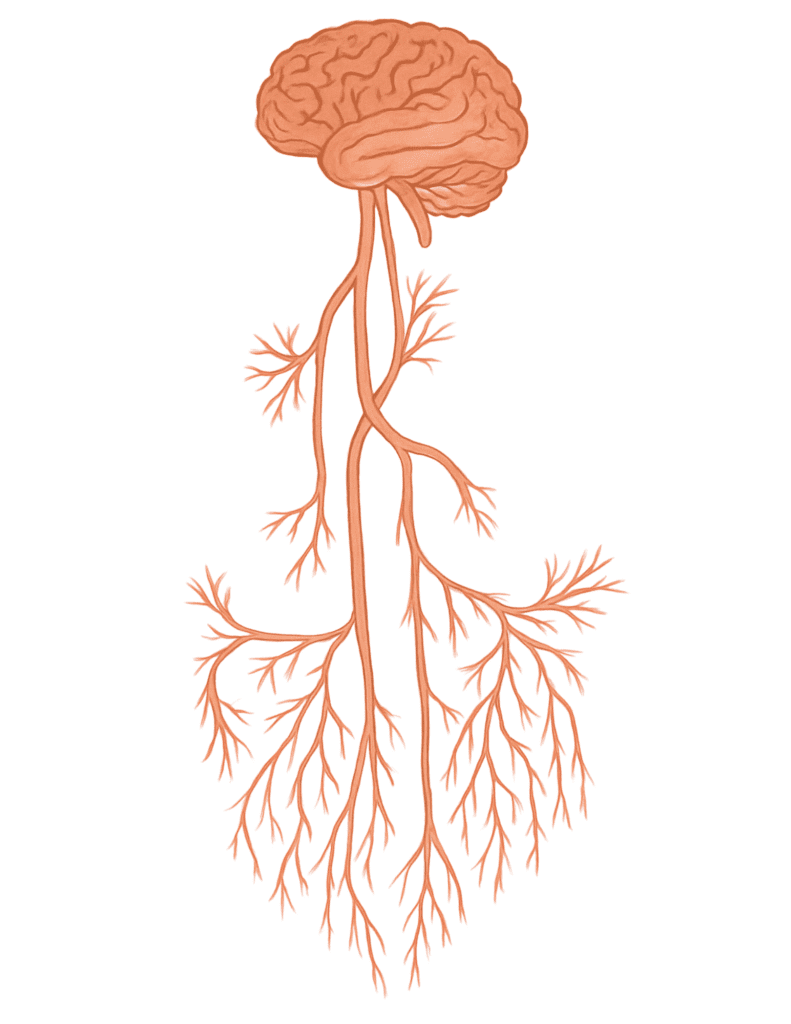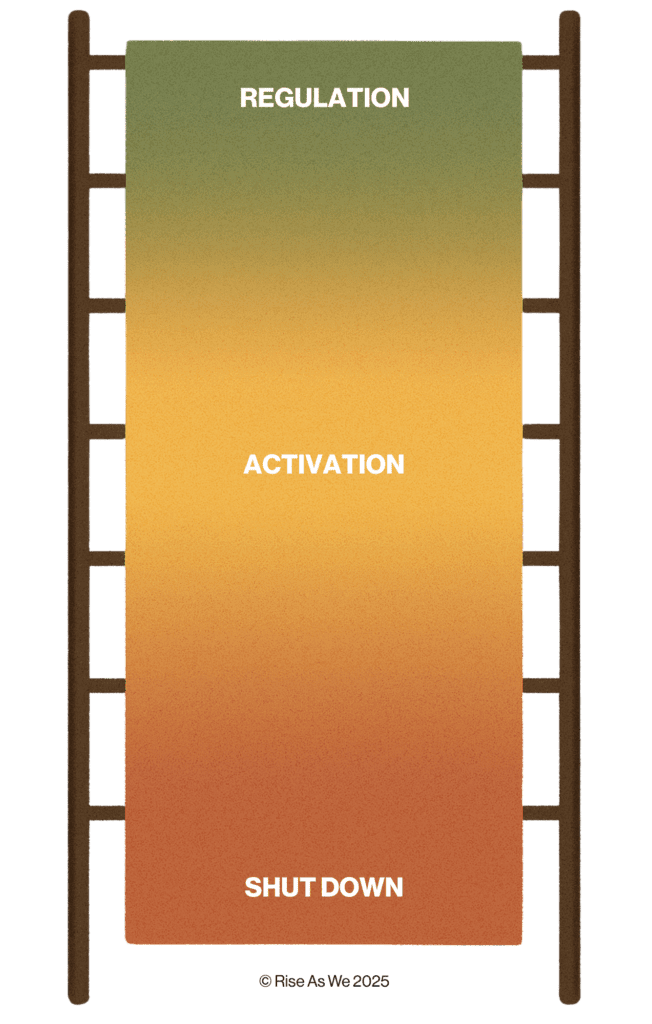Understanding Anxiety & Depression Through a Nervous System Lens
Anxiety and depression are not just in your head.
That might sound surprising, especially if you’ve spent years in talk therapy or cycling through medications trying to find relief. But if you’re still feeling stuck, there may be a missing piece in your healing journey: your nervous system.
Through the lens of nervous system science, anxiety and depression start to make more sense—not as disorders, but as adaptive responses from a body trying to protect you.
What is Your Nervous System?
Your nervous system isn’t just an abstract concept from biology class. It’s the command center that controls everything from your thoughts and emotions to your heartbeat and digestion. Think of it as an internal highway of information traveling between your mind and body—with research showing that 80% of this conversation originates from the body!
This system has one primary goal: to keep you safe.

Imagine your nervous system as an internal filing cabinet, storing memories of every time in your past when you didn’t feel safe, had your needs unmet, experienced too much instability or unpredictability, felt rejection, shame, or overwhelm.
It also acts like a lighthouse in the present moment, constantly scanning your environment, asking the question:
Is this safe? Does this person feel safe? Does this situation feel safe? Does this feel familiar to anything in my past that didn’t feel good or safe enough (checking back in with those files)?
When something in your environment resembles a past situation where you weren’t or didn’t feel safe, an internal alarm goes off. This alarm is your amygdala—your brain’s threat detection center—and it triggers your survival response.
The Nervous System Ladder: Understanding Your States
One of the most helpful frameworks for understanding anxiety and depression through a nervous system lens is the nervous system ladder, which identifies three primary states:

1. The Green Zone (Top of the Ladder)
- Your regulation zone, Parasympathetic state (“rest and digest”)
- Where you feel present, calm, and capable
- The thoughts you have here: “I can do this,” “I have what it takes”
2. The Yellow Zone (Middle of the Ladder)
- Your activation zone, Sympathetic state (“fight or flight”)
- Where you feel mobilized, urgent, and anxious
- The thoughts you have here: “I have to do this right now or else,” “Something bad might happen”
3. The Red Zone (Bottom of the Ladder)
- Your shutdown zone, Dorsal vagal state
- Where you feel numb, disconnected, and depressed
- The thoughts you have here: “I can’t do this,” “What’s the point,” “Nothing matters”
These aren’t just theoretical concepts—each state creates measurable changes in your body. Your heart rate, breathing patterns, digestion, and even visual perception shift depending on which nervous system state you’re experiencing.
Let’s make this a bit more real…
Now, imagine you, standing at the top of that ladder, holding a bucket. a ladder. At the top is your green zone—your regulated state. This bucket represents your nervous system’s capacity for stress. When the stress load on your nervous system (or in your bucket) is light, it’s easy to stay at the top of the ladder, in the green zone where you feel calm, present, and safe. But as your stress load increases, it pushes you further down the ladder into the yellow zone—your fight-or-flight state—where anxiety shows up. If the stress continues without relief, your system can get pushed even further into the red zone—shutdown and disconnection, where depression often lives.
Understanding your anxiety or depression symptoms like this, through a nervous system lens, you can start to understand that these aren’t character flaws but instead they’re protective responses to overwhelming circumstances.
It’s about balance, not perfection.
Having a regulated nervous system doesn’t mean you always feel calm or happy. It means you have the awareness to recognize when you’re dysregulated and the tools you need to reset to a regulated baseline.
Life will always include stressors that move us down that nervous system ladder. The goal isn’t to eliminate these responses but to build the capacity to move through them with more ease and resilience.
Why Anxiety and Depression Symptoms Often Make Sense
When we understand anxiety and depression through this nervous system lens, something profound happens: we realize these conditions aren’t who we are—they’re states we move through.
Your current nervous system state is always a reflection of three factors:
- Your past lived experiences
- Your current life circumstances
- The regulating tools or supportive resources you have (or don’t have)
This means your anxiety or depression isn’t a character flaw or a sign that you’re broken. They’re normal responses to abnormal circumstances.
Anxiety (or activation) when you are under-sleeping, over-stressed or have a gut imbalance isn’t a disorder, it’s order.
Depression (or shut down) when you’re micronutrient deficient, sedentary, burnt out, or feeling lonely isn’t a disorder, it’s order.
Both are natural, physiological and psychological, responses to unnatural circumstances. Both are natural responses to getting too much of something, or not enough of the things that humans require to be well.
Again, if you’ve been stuck in the yellow zone (anxiety) for a long time, eventually your system may push you into the red zone (depression). Think about it—you can only run an engine at full speed for so long before it breaks down. Your body’s shutdown response might be trying to force you to rest when you’ve been ignoring its signals for too long.
Why Traditional Approaches Often Fall Short (& a Path Forward)
Traditional mental health approaches often focus exclusively on changing your thoughts or managing your symptoms. And while mindset work and medication can absolutely have value, they often don’t address the underlying physiological or somatic (body-based) components of mental health.
For example: No amount of positive thinking will regulate a nervous system stuck in chronic hyperarousal. You can’t mindset your way out of burnout, low cortisol, or nutrient deficiencies.
But when we understand that anxiety and depression through a nervous system lens, we can take a more comprehensive approach:
- Build awareness: Learn to identify which nervous system state you’re in throughout the day. What sensations, emotions, thoughts, and behaviors signal that you’re in the green, yellow, or red zone?
- Develop regulation tools: Discover which practices help you return to your regulated baseline. Different tools work for different states—what helps you move from yellow to green might be different from what helps you move from red to green.
- Address lifestyle factors: Examine the balance between stressors and supporters in your life. Are you getting enough sleep, movement, nutrition, and connection? Are you minimizing the things that consistently dysregulate you? How’s your bloodwork look?
- Understand your patterns: Recognize how your past experiences have shaped your current nervous system responses. With this understanding, you can develop more self-compassion and more effective strategies.
The most profound shift happens when we stop asking “What’s wrong with me?” and start asking “What happened to me? What’s going on? What is my system trying to protect me from?”
A Better Way to Feel Better
When you understand anxiety and depression through this nervous system lens, healing becomes less about “fixing what’s broken” and more about reclaiming your inherent capacity for regulation and resilience.
Your nervous system is plastic and malleable. If you can dysregulate it, you can regulate it. And that simple truth brings profound hope to the healing journey.
At Regulated Living, we support individuals in healing anxiety and depression by:
- Teaching daily nervous system regulation tools
- Exploring root causes (including physiological health)
- Helping clients create a tangible plan shift out of chronic dysregulation
- Creating supportive environments, habits, and relationships
Because true healing happens when you stop trying to just “fix the mind” and start listening to the body.
Ready for a new way of healing?
Ready to learn more about working with your nervous system to heal anxiety and depression? Click here to learn more about our programs. To get started today apply for one-on-one coaching through Restore or to join my monthly membership program.
Disclaimer: This article is for informational purposes only and is not a substitute for professional medical advice, diagnosis, or treatment. Always seek the advice of your physician or qualified mental health provider with any questions you may have regarding a medical condition.
Leave a Reply Cancel reply
A mental health newsletter that feels like a deep breath: simple, grounding, and here to remind you that healing is possible.
The Weekly Rewire
Navigate
Regulated Living provides neuroscience-backed mental health coaching to help you regulate your nervous system and reclaim your life from anxiety and depression.
Heal
Learn
Paragraph